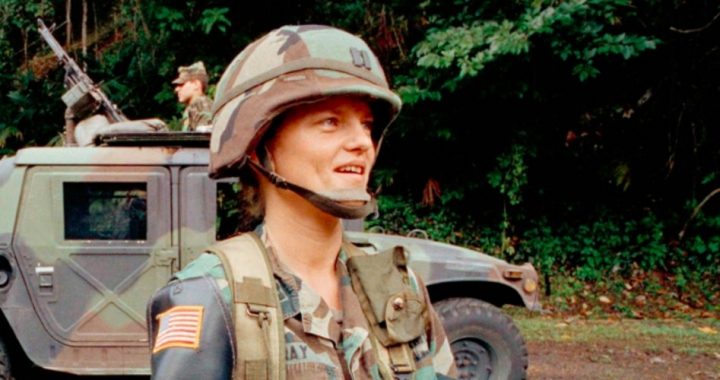
In January, Obama’s soon-to-resign Defense Secretary Leon Panetta said that women will be assigned to combat missions in the U.S. military. The object, we were told, was “to provide a level, gender-neutral playing field” so that women can enter combat positions, since not being permitted to fight holds back careers. This assumes that the purpose of the military is advancing careers, not defending the country. Thus, women will march alongside men into the meatgrinder of war if Congress doesn’t stop it.
Feminists have been pushing for the change for at least 20 years. In 1992, the Presidential Commission on the Assignment of Women in the Armed Forces decided that placing women in combat wasn’t such a bright idea. The commission proved that assigning women to combat roles was palpably ridiculous on practical grounds. Women, it was learned, to the surprise and chagrin of some, are not men. Noted commissioner Charles Moskos, the idea that women should fight alongside men suggests the opposite: Women are little men, and men are just big women.
Evidence showing the profound physiological differences between the sexes proved that to be false, and it also showed that even accommodating women on the battlefield raised profound sociological and moral questions.
Here, then, is what Panetta has done: ignored what recorded history tells us about the nature of man to accommodate feminism.
The Practical Case
Perhaps one of the most striking pieces of evidence the commission saw was a graph showing that, generally speaking, the strongest military woman is only as strong as the weakest military man. Another interesting datum showed that the average 20-something woman has the lung power of the average 50-something man. Imagine a woman combat commander in her 40s trying to keep pace with young men on a forced march, something that men who lead combat troops are required to do.
Bearing this out are data from the Marine Corps, which were presented to the Defense Advisory Committee on Women in the Services (DACOWITS). Studies show, the Marines told DACOWITS in 2011, that women are endowed with 20 percent lower aerobic power than men, 40 percent lower muscle strength, 47 percent lower lifting strength, and 26 percent slower road-march speed. In addition, their attrition rate from injuries is twice that of men; their nondeployable rate three times higher.
How will the military get past human physiology? By ignoring it. As the Center for Military Readiness (CMR) noted when the decision was announced, the military will drop its standards to accommodate women.
“The tipoff came during the January 24 Pentagon news conference conducted by Panetta and Army Gen. Martin Dempsey, chairman of the Joint Chiefs of Staff,” CMR reported:
Gen. Dempsey said that if “a particular standard is so high that a woman couldn’t make it, the burden is now on the service to come back and explain … why is it that high? Does it really have to be that high?” Since the stated goal is “set women up for success,” the answer will be “No.”
Training standards in the military will most certainly drop, CMR noted, pointing to the Marines’ slide show for DACOWITS, which included the data on the comparative strength and attrition rates on men and women. That presentation included “six tasks that both men and women would be required to perform” as a measure of their ground combat suitability. The tasks were:
• March under Load — 20km in five hours with 83 pounds assault load
• Perform individual movement techniques — crawl, sprint, negotiate obstacle, etc., with 83 pounds assault load
• Move a casualty — individual carry, 165 pounds average Marine casualty with 83 pounds assault load on him, carrying own 83 pounds assault load for a 20 meters distance (distance proposed GCE standard) (total casualty weight 248 lbs.)
• Defend a position — by fire and armed/unarmed close combat if required, with 83 pounds assault load
• Construct a machinegun fighting position — to specified dimensions; time standard TBD; wearing standard body armor (43 lbs.)
• Mount heavy machine gun on tripod — with 83 pounds assault load, manipulating MK19 heavy machine gun (83 lbs.), M3 tripod (44 lbs.) and ammunition
According to CMR, “Sometime after the September 2011 briefing, however, three of the original six ‘common standards’ tests were modified or watered down, and the remaining three — tests that would have been more physically demanding — were dropped.” Here are the new tests:
• Heavy Machine Gun Lift: Marines lift machine gun replica (72.5 lbs.) from the ground to overhead, one repetition, wearing average assault load of 71 pounds.
• Casualty Evacuation: Participants, wearing a fighting load of 43 lbs., evacuate (drag) a simulated casualty for a distance of 25 meters (82 feet). The casualty’s total weight will be approximately 208 pounds (rescue mannequin of 165 lbs. plus a 43 lb. fighting load). Participant sprints 25 meters to the casualty.
• March Under Load: Wearing average assault load (71 lbs.) completes 20 km march (12.4 mi.) in five hours or less.
“The changes reduce the training challenges for men, while making it more likely that women will succeed,” CMR correctly concluded. The requirements were reduced, even though combat conditions would likely require soldiers to bear heavier loads than the originally proposed test would have required, not lighter. According to Jerry Whitaker, affairs officer for the U.S. Army Soldier Systems Center, as reported by Forbes, “In Afghanistan, infantrymen are carrying upwards of 120 pounds — in Iraq 100 pounds.”
Officer training, CMR noted, is already “gender-normed” for women. Gender-norming is the military bureaucracy’s term for lowering standards so that women can make it through basic training without collapsing. “The [Marine Corps’] Officer Candidate School (OCS) obstacle course [Quantico, Va.], as on many other bases, has two side-by side paths with barriers that trainees must climb over — one for males and one for female officer candidates,” CMR reported:
Photos of the OCS obstacle course clearly show that a high bar on the female course is 12 inches lower than a similar bar on the men’s side. Discrete wooden “assists” nailed to side posts and the fronts of a climbing wall provide toe-hold help for women climbing over barriers on that side.
According to a source in the Marines, CMR reported, women flunked the OCS Combat Readiness Test (CRT). “Even with the female assists and longer time or lower mileage requirements in running exercises, 63% of the women failed that class’s CRT, compared to 1% of the men. (15 women, 3 men) On overall physical fitness scores, 46% of the females failed, no males did. Attrition was roughly double.”
So despite gender norming, military women still have difficulty with the training.
And that’s because, again, women aren’t men. A letter from a retired Navy doctor to Rep. Buck McKeon (R-Calif.) explained the difference between men and women in terms of testosterone. Noted Adm. Hugh Scott:
While men and women have an equal number of muscles and muscle fibers, the strength difference relates exclusively to muscle size that is determined by testosterone levels.
Because women have less testosterone than men, they have smaller muscle fibers that result in the development of small-size muscles; in effect, women have less muscle to activate. That also is the reason why women develop less muscle when training with weights and exercising.
The anabolic effects of testosterone make men at least 30% stronger than women, especially in the upper body musculature, which provides a greater capability for doing the kind of heavy manual work associated with combat arms, such as carrying full packs, on forced marches, along with lugging weapons and ammunition, handling the radios, and when necessary carrying a wounded or dead comrade. Indeed, there is little overlap between the distributions of male and female upper-body strength.
Another male testosterone effect is that it increases the total quantity of bone matrix and calcium retention, in males, which result in a heavier and stronger skeleton.
Thus, as CMR explained in its list of seven reasons to oppose women in combat, those who advocate the women-in-battle policy insist that requiring women to meet the same standards as men would be unfair:
The same advocates who demand “equal opportunities” in combat are the first to demand unequal, gender-normed standards to make it “fair.” General Robert W. Cone, who heads the Army’s Training and Doctrine Command (TRADOC) admitted this in an interview with the Defense Department’s house-organ American Forces Press Service. Said Gen. Cone, “Soldiers — both men and women — want fair and meaningful standards to be developed for accepting women into previously restricted specialties. I think that fairness is very important in a values-based organization like our Army.”
CMR noted that the enemy is not going to be “fair” to women by taking into account their weakness. They will be raped and killed. Combat terrain cannot be gender-normed. Nor can the distance for a march between two points on a map be shortened. An outstanding woman Marine explained this truth in an article for Marine Corps Gazette. “Get Over It!” the headline ran. “We Are Not All Created Equal.”
The piece by Capt. Katie Petrino knocks down the feminist fantasy, inspired not only by ideology but also Hollywood fairy tales of warrior princesses leading clueless men into battle:
“I was a star ice hockey player at Bowdoin College, a small elite college in Maine, with a major in government and law,” Petrino wrote. “At 5 feet 3 inches I was squatting 200 pounds and benching 145 pounds when I graduated in 2007. I completed Officer Candidates School (OCS) ranked 4 of 52 candidates, graduated 48 of 261 from TBS, and finished second at MOS school. I also repeatedly scored far above average in all female-based physical fitness tests (for example, earning a 292 out of 300 on the Marine physical fitness test). Five years later, I am physically not the woman I once was and my views have greatly changed on the possibility of women having successful long careers while serving in the infantry.”
During her 10-month deployment to Iraq, Petrino “participat[ed] in numerous combat operations.” That physical stress led to restless leg syndrome, and “Iraq was a pleasant experience compared to the experiences I endured during my deployment to Afghanistan.” There, this top-flight woman athlete literally broke down after 16-hour days:
By the fifth month into the deployment, I had muscle atrophy in my thighs that was causing me to constantly trip and my legs to buckle with the slightest grade change. My agility during firefights and mobility on and off vehicles and perimeter walls was seriously hindering my response time and overall capability. It was evident that stress and muscular deterioration was affecting everyone regardless of gender; however, the rate of my deterioration was noticeably faster than that of male Marines and further compounded by gender-specific medical conditions. At the end of the 7-month deployment, and the construction of 18 PBs [Patrol Bases] later, I had lost 17 pounds and was diagnosed with polycystic ovarian syndrome (which personally resulted in infertility, but is not a genetic trend in my family), which was brought on by the chemical and physical changes endured during deployment. Regardless of my deteriorating physical stature, I was extremely successful during both of my combat tours, serving beside my infantry brethren and gaining the respect of every unit I supported. Regardless, I can say with 100 percent assurance that despite my accomplishments, there is no way I could endure the physical demands of the infantrymen whom I worked beside as their combat load and constant deployment cycle would leave me facing medical separation long before the option of retirement. I understand that everyone is affected differently; however, I am confident that should the Marine Corps attempt to fully integrate women into the infantry, we as an institution are going to experience a colossal increase in crippling and career-ending medical conditions for females.
Substandard physical prowess is just one practical reason women should not be assigned to combat. Another is that women, as a group, are not psychologically fit for it. The paper entitled “Band of Brothers or Band of Siblings” explained that women are much more afraid of risk to physical safety: “When two snipers were terrorizing the Washington, D.C., area in 2002, women reported being substantially more likely than men to modify their behaviors, even though objectively there was a very low risk of harm and men made up more than two-thirds of the sniping victims.” As well, they are less physically aggressive than men: “Fights among school children, for example, are overwhelmingly between boys…. A meta-analysis of aggression studies found that the age group showing the largest sex difference is 18 [to] 21-year-olds … followed closely by 22 [to] 30-year-olds … the prime demographics for combat soldiers. As aggressive behavior becomes more dangerous, the sex difference in aggression increases.” Almost all murderers are men, the paper noted, and men are much more likely to accept and use physical aggression to solve problems.
On the other hand, the paper noted, women are more empathetic and nurturing than men: “Women are likely to feel greater empathy for the enemy (and more fear) than men,” which accounts for their a higher rate of post-traumatic stress disorder, even when “they are exposed to substantially less combat danger. [Emphasis added.] Thus, women may be less likely than men to kill and more likely to pay a heavy psychological cost for it when they do.”
So those who propose assigning women to combat are creating “soldiers” who are less likely to kill.
Regardless of Petrino’s warning, many, including “conservative” women, insist that some “exceptional women” can meet the same standards as men and be just as willing to kill. Why, they ask, shouldn’t they fight? The answer, the commission of 1992 learned, is that recruiting such women, which assumes they want to be recruited, would be prohibitively expensive. Second, even if such women exist, their physical prowess does not eliminate other concerns about women in the field such as privacy, feminine hygiene, fraternization, and, of course, pregnancy. Third, assigning women to combat is not merely a practical matter. It is a moral issue as well.
Of course, as CMR noted, whether women meet any standard won’t be easy to determine given that men will promote them no matter what. Careers will depend upon the “successful integration” of women into combat units. The commission of 20 years ago learned that performance evaluations for commanders in Naval aviation were partly based on how many women they pushed through the program. That mindset to promote unqualified women led to the death of the first woman carrier pilot, Kara Hultgreen, who could not land her disabled F-14 on the USS Abraham Lincoln. During her approach to the carrier, she made errors similar to errors made during her training. Hultgreen was incompetent, but the Navy put her in the air anyway. As Dempsey said in January, if standards are so high that women can’t meet them, then the military must justify the standards. “Speaking the language of social engineers, not combat veterans,” CMR noted, “Gen. Dempsey admitted the need to introduce a ‘critical mass’ or ‘significant cadre’ of women into previously-all-male units. This phrase, usually interpreted to mean a cohort of 10-15 percent, cannot be met with a few exceptional women who ‘only want a chance.’”
Beyond all this, a legal question looms. The exemption of women from the draft, settled by the U.S. Supreme Court in Rostker v. Goldberg, is based upon the military policy of sending only men into war. Now that women are eligible to fight, the courts may revisit that question should some young man file an equal-protection lawsuit. Meanwhile, federal law requires the Pentagon to provide a legal analysis of the question. If the Supreme Court decision is precedent, the Pentagon analyzers will be forced to conclude that women must register for the draft.
The Moral Case
Yet the real question has never been whether women can fight, although finding capable women for all-volunteer forces would be a monumental waste of money, given that so few women can, and that the military does not need women in combat roles. Rather, the question is whether women should. That’s how former Marine Col. Ron Ray, a Silver Star recipient who served on the commission in 1992, put it.
How will the military train men and women for combat? If standards change — meaning they are lowered — military preparedness, unit cohesion, and morale will suffer. If the standards are the same, women will fail. As well, sex-segregated training can no longer be allowed. Women will have to grapple with men in training with such implements as pugil sticks. That means a young man whose mother has taught him, as mothers have often taught sons, never to strike a woman, must become inured to harming women without compunction. Granted, some men have already become inured to it, thanks to our culture of violence and mayhem. But most haven’t, and they, ultimately, must learn to watch women die while doing nothing to help them. A man will be told he may not sacrifice his mission by responding to his natural and maternally reinforced instinct to protect women. But regardless of what they are told, many men will sacrifice the mission and even their own lives trying to assist the women.
How will the military accommodate women in combat operations? Will women with debilitating menstrual periods be shipped out of a combat zone? Then there’s pregnancy. As Elaine Donnelly, president of CMR, has noted, during the 1990s about 15 percent of military women were nondeployable because of pregnancy. Another snapshot came from the USS Theodore Roosevelt, an aircraft carrier. Donnelly reported, “45 of 300 women did not deploy or complete the cruise due to impending childbirth. Eleven of the 45 were flown off the ship while underway.” If men want to get out of their combat tour, it is nigh unto impossible unless they complete their tour or get injured. Women need only to become pregnant.
The military must grab the nettle of simple modesty and decency in the field, along with feminine hygiene, which doesn’t much bother the radical egalitarians, but might well bother a young man or woman raised in a Christian household. Women in the field will be a particular problem if two men in the unit are competing for her attention or sexual favors, a problem that leadership will not solve, despite what the supporters of women in combat told the commission 20 years ago. As well, married men and women will be deployed for long periods of time away from husbands and wives, which will put the deployed spouses in captive and nearly irresistible situations of temptation to adultery. This, of course, happens now.
Yet even these matters are in some sense still practical. So again, the real question is moral: Should women serve in combat? If not, why not? The answer is that assigning women to combat is a moral outrage. Assigning women to combat is egalitarianism of a different order than permitting them to be doctors, lawyers, and journalists. Assigning women to combat is a radical attack on the natural complementarity of the sexes; that is, that God created men and women differently for a good reason, that one sex can do things for which nature has not prepared the other.
Petrino noted that none of the military women she knew were pushing for combat assignments. Twenty years ago, the commission learned that the most hardened combat vets, almost to a man, strongly opposed opening combat roles to women. There’s a reason for that: It’s dangerous for the women, the men around them, the military, and the country.
— Photo: AP Images



